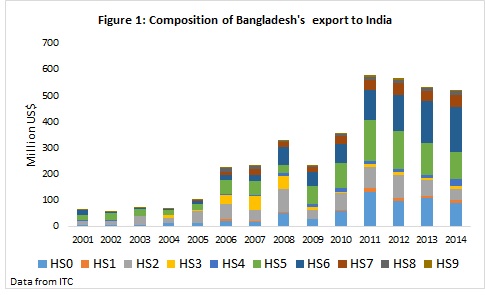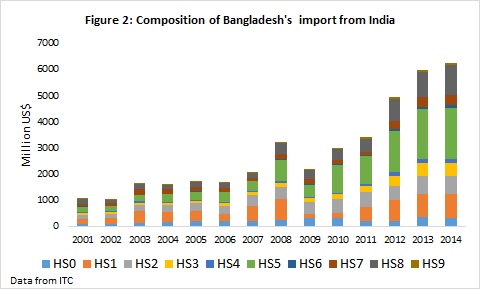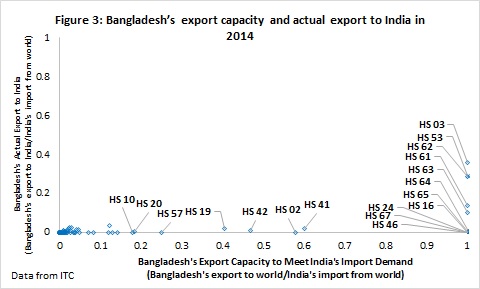Bangladesh and India have long bonds in culture and history. Despite such bonds and neighborly proximity, economic cooperation between the two countries has remained far below potential. A number of studies have shown that bilateral trade and investment offer immense opportunities for accelerating growth and reducing poverty in Bangladesh and India. These studies suggest that India could become a major player for accelerating the growth of intra-industry trade and uplifting foreign direct investment (FDI) inflow to Bangladesh. Also, for India, Bangladesh could become an additional source of trade as well as a critical destination for investment thus addressing many concerns relating to the economic isolation of its backward Eastern and North-Eastern states. Furthermore, better connectivity between Bangladesh and India through multi-modal transport and transit facilities will further enhance the strength of the economic relations between these two countries.
Although it experiences annual volatility, the overall trade between Bangladesh and India has increased over time, and the balance of trade remained heavily in favor of India. Total exports from Bangladesh to India increased from US$ 50.2 million in 2001-02 to US$ 527.2 million in 2014-15 (which was only 0.1% of India’s total import). The share of Bangladesh’s exports to India in the country’s overall export increased from 0.3% to around 1.5% during the same period. On the other hand, India’s exports to Bangladesh increased from about US$ 1019 million in 2001-02 to US$ 5.8 billion in 2014-15 (around 2% of India’s total export). At present, India is the second-largest import source for Bangladesh. In 2014-15, the share of Bangladesh’s imports from India was around 16% of the country’s total imports from the world.
Looking at the product details we find that in recent years Bangladesh’s exports to India (Figure 1) have been dominated by readymade garments (RMG) (HS code 6) and jute products (HS code 5). Bangladesh also exports products like textile articles, edible fruit and nuts, salt, fish, inorganic chemicals, mineral fuels, and raw hides and skins. In contrast, large parts of Bangladesh’s import from India have been raw materials and capital machinery (HS codes 5 and 8) (Figure 2) which are used in Bangladesh’s export-oriented and domestic industries. At the product details, Bangladesh’s import from India for the last decade was chiefly cotton, vehicles, and parts and accessories, machinery, cereals, man-made staple fibers, iron and steel, electrical machinery, organic chemicals, tanning or dyeing extracts, and plastics.



Though exports from Bangladesh were supposed to increase significantly as the Indian government offered Bangladesh duty-free benefit for all products except 25 alcoholic and beverage items since November 2012, exports did not increase much after 2012. A number of challenges can be made responsible for such weak export response which is related to Bangladesh’s limited export capacity, lack of diversification of export baskets, and various non-tariff measures (NTMs) and procedural obstacles (POs) due to inadequate infrastructure and lack of support facilities both at home and in the Indian market.
It is noteworthy that readymade garments (RMG) have become the major item in Bangladesh’s export to India on account of duty-free market access granted by India. In 2009-10, the share of RMG was more than 28% in total export of Bangladesh to India, which rose to 34.3% by 2014-15. However, studies have shown that there are many products in which Bangladesh has large export capacities, but actual exports to India are either very low or zero. For example, Figure 3 shows that though for products in the HS categories of 02, 16, 24, 41, 46, 64, 65 and 67, Bangladesh has either the full or significantly partial export capacities to meet India’s import demand, actual exports to India are zero. Similar observation also holds for Indian exports to Bangladesh. Therefore, there is enormous scope for raising bilateral trade between the two countries. There is a need to explore carefully, how different NTMs and POs and lack of trade facilitation affect such prospects. Necessary measures should be taken to improve the scenario. In order to address the trade infrastructural problems at the border, lately, there are some initiatives by the Government of India to set up Integrated Check Posts (ICPs) at major entry points on the land borders between Bangladesh and India. Two such ICPs have been launched recently, and they are expected to boost bilateral trade.
Bangladesh and India have to tap on the trade-investment nexus for improving their bilateral economic cooperation. The horizontal and vertical integration of Indian and Bangladeshi industries could help to improve scale economies, especially for Bangladesh, and help Indian firms gain from the use of cheap labor in Bangladesh. However, in terms of sources of FDI inflow in Bangladesh, the US, the UK, and South Korea top the list of countries, and FDI from India is still very low.
Lately, there have been a number of initiatives between Bangladesh and Indian governments to improve the investment situation. The Bangladesh Power Development Board and the Indian National Thermal Power Corporation have signed a memorandum of understanding in 2010 to set up two coal-fired power plants, each of which will have a capacity of 1,320MW, with partnership shared equally between them. Furthermore, recently, Bangladesh has offered India to establish two Special Economic Zones (SEZ) for Indian companies. Launching of these SEZs are expected to substantially increase Indian FDI into Bangladesh.
In 2015, Prime Ministers of India and Bangladesh contracted international gateway of internet service in Agartala and supply of 100MW power to Bangladesh from Tripura. India is already supplying 500 MW of power to Bangladesh, and supply of another 500 MW was also announced during the Indian Prime Minister’s visit to Bangladesh in 2015. On the other hand, the bandwidth connection came as Bharat Sanchar Nigam Limited (BSNL) and Bangladesh Submarine Cable Company Limited (BSCCL) signed an agreement for the leasing of international bandwidth for Internet at Akhaura. As a result, Agartala has become the third station connected to submarine cable for Internet bandwidth after Chennai and Mumbai. The internet bandwidth export to India from Bangladesh will enable reliable and fast Internet connectivity for the people of Tripura as well as other parts of India’s northeastern region.
It is expected that the latest shipping arrangement between Bangladesh and India would make the faster movement of goods between these two countries. Currently, such shipments are routed via Colombo or Singapore. Also, it takes around 20 days for a shipment by land. However, the direct shipping is expected to reduce the time to around 7 days, as there is no longer a need for transshipment at Colombo. The service will play a vital role in decongesting the border points and bringing down the cost and transit time involved. This improved arrangement of connectivity would bring better efficiency and thus provide the best competitive freight rates to the advantage of the industries.
The aforementioned analyses point to the fact that there are heightened political commitments among the governments of both Bangladesh and India to improve bilateral economic cooperation through different initiatives. Such initiatives need to be materialized at the earliest. As for Bangladesh, to make the most out of such initiatives, there are a number of challenges though. The country needs to significantly improve the business environment for attracting FDI, as the latest World Bank’s ranking of the ease of doing business shows that Bangladesh’s position dropped two steps to 174 out of 189 countries due to stalled regulatory reforms.
Finally, besides the abovementioned economic issues, still, there are some bilateral issues between Bangladesh and India, which need to be resolved for enriching mutual trust and confidence for greater economic cooperation. For example, border killing is an issue that strains India-Bangladesh relations as the victims are often ordinary people of Bangladesh living in border areas. This needs to stop, for which a political decision at the highest level is necessary. Also, the water-sharing issue between India and Bangladesh is yet to be solved properly, which undermines a lot of the developmental prospects. However, it can be hoped that these issues will be solved with the heightened commitment among the political elites of the two countries for deeper economic cooperation.
This article is written by Dr. Selim Raihan and Dr. Farazi Binti Ferdous


RECENT COMMENTS